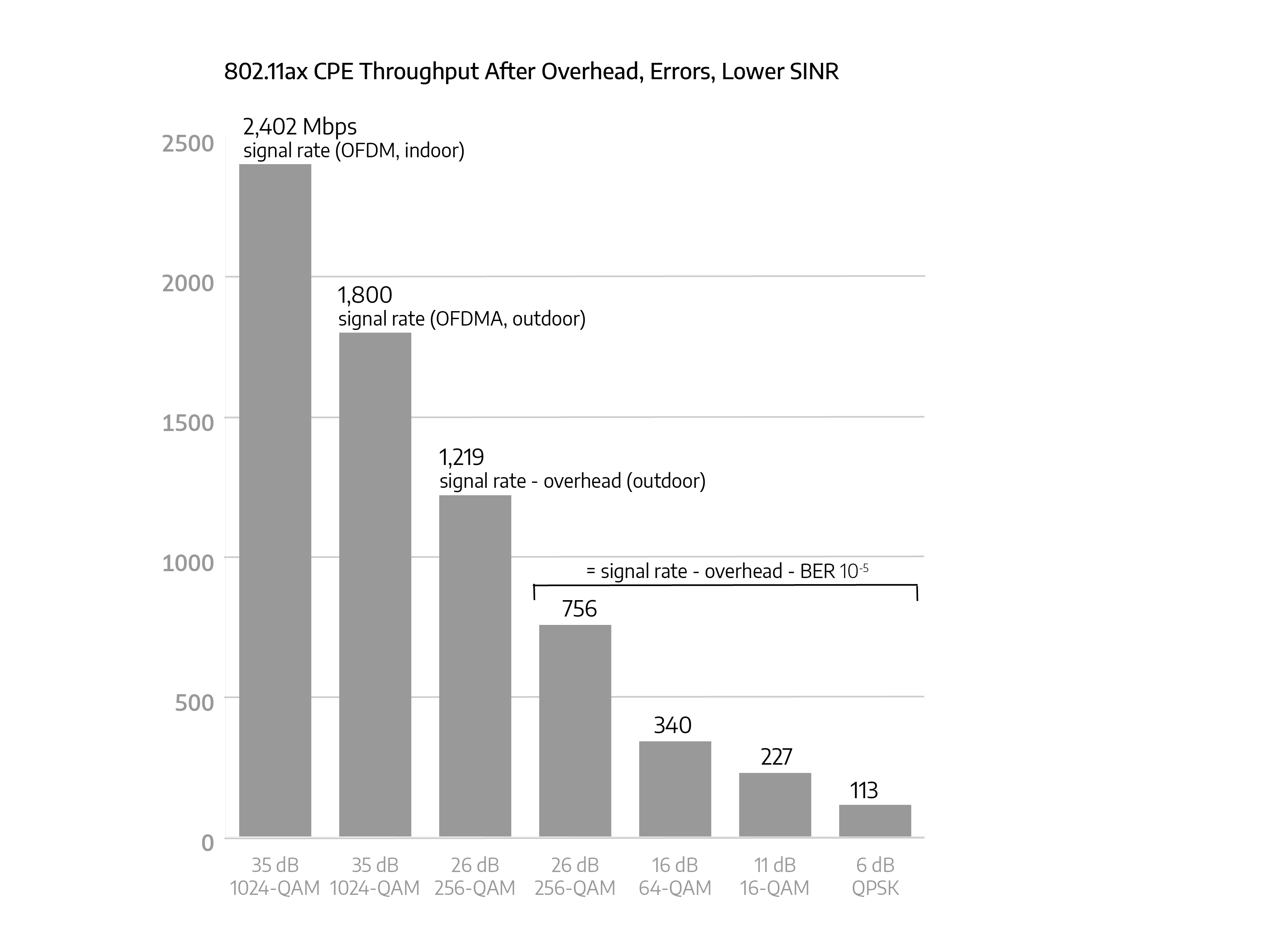Nobody likes paying taxes and that applies equally to broadband. It’s hard enough designing links for optimal performance only to lose a chunk of that throughput to overhead.
The 802.11 Tax
Any communications technology requires some overhead for operations such as control and management. The specific amount can vary greatly depending on the technology. It should not be a surprise that the 802.11 standard – with its many mobile client features and backwards compatibility requirements – incurs substantial overhead. The latest 802.11 standard (802.11ax aka Wi-Fi 6) uses 30% of the raw available throughput just in overhead. This includes:
- Control frames
- Sounding and feedback
- AIFS, SIFS, BO
- Preambles and headers
This tax on bandwidth can create a dramatic difference between marketing specifications and real-world performance. Understanding the difference is important. Without a thorough grounding in a network’s true performance the operator risks building a network that can’t handle the required amount of traffic. This has the knock on effects of unhappy customers and churn. Fixing a problem like this isn’t easy either. In the worst case, it could potentially require a complete network redesign. Better to have an architecture that works as expected and designed from day one. But in order to do this you need to understand the relationship between the hype of marketing performance numbers and the reality of a fixed wireless access deployment.
Real World vs. Perfect World
At Tarana, we spend a lot of time thinking about radios and how they work and decided to take some time to work out where the bandwidth goes from a first principles perspective. The following graph shows how big a bite overhead and other factors can take from advertised rates:

Figure 1: 802.11ax data rate by varying SINR, QAM, and nLoS/NLoS conditions
When allowances are taken for moving from an indoor to an outdoor environment – for example a greater number of pilots are needed to deal with nLoS and NLoS multipath frequency dispersion – the available link throughput is reduced by 25% (market rate of 2.4 Gbps to 1.8 Gbps). Removing control and management overhead drops the available link throughput even further to 1.3 Gbps. It should be noted that, in this example, we start with the maximum advertised throughput in perfect conditions for a 2×2:2 802.11ax client (35 dB SINR, 1024-QAM, indoor). Since most outdoor links are anything but perfect, a very good environment (26 dB SINR, 256-QAM, including all overhead and BER = 10-5) and nLoS/NLoS conditions knocks the available throughput down dramatically below advertised throughput. That’s a lot of throughput to give up.
When SINR drops to 16 dB and average outdoor conditions, throughput is a fraction of where we started. Further reductions in SINR (11 dB and 6 dB) will occur due to increasing self-interference (in cell and adjacent cell) and uncontrolled unlicensed band interference. As the operator is successful and adds subscribers they will also add interference which lowers everybody’s throughput. In this case success (more subscribers) breeds trouble in terms of link degradation and customer dissatisfaction. It’s a tricky balance and yet another reason why real-world performance differs so dramatically from what is seen in a lab.
802.11ax is a great technology for primarily indoor enterprise and home Wi-Fi networks in line-of-sight environments but when it comes to fixed wireless that goodness doesn’t translate well. None of the above takes into account other variables key to fixed wireless networks such as sector (AP) capacity. Stay tuned and we’ll have another blog that dives even deeper into these topics.
G1: Purpose-built for Next-generation FWA
Unlike the high taxes incurred by Wi-Fi, a G1 link gives up just 14% for overhead. This takes a link from a maximum radio signaling rate of 922 Mbps to 800 Mbps. This rate assumes 26 dB SINR and 256-QAM in nLoS conditions – both of which are reasonable and achievable conditions for many deployments. Unlike other technologies that rely on marketing hype, G1 was designed with the assumption of realistic operating conditions rather than the perfection of a lab. This includes the ability to cancel uncontrolled unlicensed band interference with performance nearing that of licensed bands.
The reason G1 is so much more efficient is easy to understand: G1 was designed explicitly for ngFWA. There is no need to preserve backwards compatibility with old standards or to implement mechanisms that will never be needed (like mobile clients). Less overhead means more available throughput for your customers.
Those who are familiar with Tarana may have noticed our literature only advertises the second rate – 800 Mbps – rather than the higher raw rate. That’s because we want our customers to know exactly what to expect from G1 rather than marketing hype.
Feedback from our customers has been unanimous in their appreciation. “You do exactly what you say you’ll do” is something we hear a lot. With G1, operators can design and build large scale FWA networks and trust they will do exactly what they’re supposed to do. No surprises. No unnecessary taxes.
If you just can’t wait to learn more, check out our other blogs or some of our favorite customer links. Or reach out to us at info@taranawireless.com. We’d love to hear from you.


